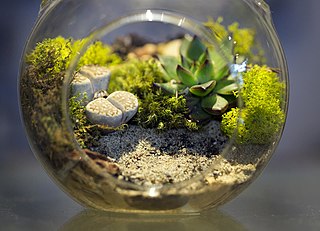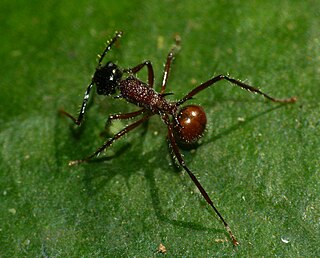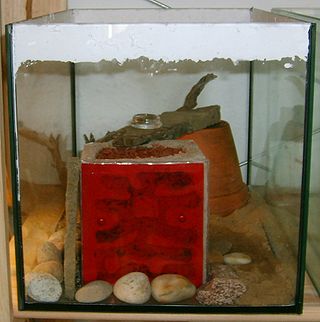
A formicarium (pl.: formicaria or formicariums) or ant farm is a vivarium which is designed primarily for the study of ant colonies and how ants behave and for the enjoyment of ants as pets. Those who study ant behavior are known as myrmecologists.

A formicarium (pl.: formicaria or formicariums) or ant farm is a vivarium which is designed primarily for the study of ant colonies and how ants behave and for the enjoyment of ants as pets. Those who study ant behavior are known as myrmecologists.
The formicarium was invented by Charles Janet, a French entomologist and polymath, who had the idea of reducing the three dimensions of an ant nest to the virtual two dimensions between two panes of glass. [1] His design was exhibited in the 1900 Exposition Universelle in Paris. Janet's invention was recognized by his promotion to Chevalier (Knight) of the Legion of Honour, but he did not obtain a patent for, nor attempt to market his creation.
The first commercially sold formicarium was introduced around 1929 by Frank Eugene Austin (1873–1964 [2] ), an inventor and professor at the Thayer School of Engineering at Dartmouth College. [3] [4] Austin received a patent for his formicarium on June 16, 1931, [5] [6] as well as further patents for its continued development. [7] [8] Austin included whimsical painted or wooden scenes of palaces, farms and other settings above the ground level.
In 1956, Milton Levine, founder of Uncle Milton Industries, created his own version of a formicarium, reportedly independently from Frank Austin. Levine got the idea when attending a Fourth of July picnic. [9] [10] Levine registered the term ant farm for his product and registered it as a trademark. [11] Austin may not have used this term; in his patents, the formicarium is referred to as an "educational apparatus" and "scenic insect cage", and in the 1936 magazine article about Austin's device, the structure is called an "ant palace".
Levine's "Ant Farm" trademark received notoriety in 1995 when Scott Adams used the phrase in a Dilbert comic and received threatening letters from Uncle Milton Industries' attorneys, demanding a retraction for the unauthorized use of the phrase. Adams satirized the incident in a later comic strip, in which Dilbert asked for a substitute phrase for "a habitat for worthless and disgusting little creatures", to which Dogbert replied "law school". [12] [13]

Most formicarium types now available on the market are either made of acrylic (plastic) or 3D printed. These are superior to the 'sandwich' type formicarium as there is no chance of tunnel collapse, and they are designed more specifically to keep queen ants with workers, whereas the 'Milton' type nests were only designed to house worker ants.
A 'sandwich' formicarium is usually a transparent box made of glass or plastic, made thin enough so that the tunnels and cavities made by the ants can be seen and their behaviour can be studied. The fill material is typically soil, loam, sand, vermiculite, other mineral fragments or sawdust.
Formicariums containing gel that act both as fill material and partially food are available. However, they do not provide the ants with adequate housing and nutrition for the long term and in some instances, they can actually be poisonous to the ants. [14] The formula and nutritional content of gels vary, but for worker-only colonies they tend to only contain sugar or agar plus preservatives. Most gels are colored blue.
Other types of formicaria are those made with plaster, autoclaved aerated concrete (AAC) or simply with no medium. Plaster nests can be made by placing modeling clay on a glass panel in the form of tunnels and chambers. The plaster is poured onto the mold, and when the plaster dries, the clay is removed and the remaining structure can be used for housing ants. The ants in this type of formicarium are very easily seen. Mediumless formicaria may be in any container, with the ants staying in moist test tubes or other small containers. This also allows for better visibility.

A formicarium can be designed to be free-standing, and not enclosed or lidded like a vivarium. A free-standing design does not require high walls and a lid, but rather relies on barriers to secure the ants within their habitat.
Containing ants inside a formicarium can be a challenge. Several substances are used to repel the ants, including anti-escape oil, petroleum jelly or liquid PTFE, which are applied to the side of the formicarium to prevent escape, as most ant species cannot walk on these slippery or sticky surfaces. Despite this, some species of ants can build bridges of debris or dirt on the substance to escape, while in other species some individual ants can walk on the substance without impedance. Formicarium owners often make use of two or more security measures. Another escape-prevention technique involves placing the entire formicarium in a shallow container of water, creating a moat.
Some ant-keepers choose to put their ants into a 'test tube outworld' before a formicarium as this allows them to keep the colony comfortable and safe within their test tube whilst also allowing them a foraging area.
In the United States of America, it is usually illegal to ship live queen ants across state lines without a permit, and most ant farms sold in the US contain no queens. Professional ant shops and suppliers may ship ants only within the state where they reside.
In the European Union, some domestic species are protected, and it is illegal to own, keep, buy, or sell these ants, or to damage their nests. Unlike reptiles and spiders, there are no laws on owning, keeping, buying, or selling tropical ants. Most formicaria are designed to house queen ants; professional ant shops and suppliers usually sell their colonies with queens.

Paraponera clavata, commonly known as the bullet ant, is a species of ant named for its extremely painful sting. It inhabits humid lowland rainforests in Central and South America.

Solenopsis invicta, the fire ant, or red imported fire ant (RIFA), is a species of ant native to South America. A member of the genus Solenopsis in the subfamily Myrmicinae, it was described by Swiss entomologist Felix Santschi as a variant of S. saevissima in 1916. Its current specific name invicta was given to the ant in 1972 as a separate species. However, the variant and species were the same ant, and the name was preserved due to its wide use. Though South American in origin, the red imported fire ant has been accidentally introduced in Australia, New Zealand, several Asian and Caribbean countries, Europe and the United States. The red imported fire ant is polymorphic, as workers appear in different shapes and sizes. The ant's colours are red and somewhat yellowish with a brown or black gaster, but males are completely black. Red imported fire ants are dominant in altered areas and live in a wide variety of habitats. They can be found in rainforests, disturbed areas, deserts, grasslands, alongside roads and buildings, and in electrical equipment. Colonies form large mounds constructed from soil with no visible entrances because foraging tunnels are built and workers emerge far away from the nest.
Sea-Monkeys is a marketing term for brine shrimp (Artemia) sold as novelty aquarium pets. Developed in the United States in 1957 by Harold von Braunhut, they are sold as eggs intended to be added to water, and most often come bundled in a kit of three pouches and instructions. Sometimes a small tank and additional pouches are included. The product was marketed in the 1960s and 70s, especially in comic books, and remains a presence in popular culture.

Myrmica rubra, also known as the common red ant or erroneously the European fire ant, is a species of ant of the genus Myrmica, found all over Europe and is now invasive in some parts of North America and Asia. It is mainly red in colour, with slightly darker pigmentation on the head. These ants live under stones and fallen trees, and in soil. They are aggressive, often attacking rather than running away, and are equipped with a stinger, though they lack the ability to spray formic acid like the genus Formica.

A birdfeeder, bird table, or tray feeder is a device placed outdoors to supply bird food to birds. The success of a bird feeder in attracting birds depends upon its placement and the kinds of foods offered, as different species have different preferences.

A vivarium is an area, usually enclosed, for keeping and raising animals or plants for observation or research. Water-based vivaria may have open tops providing they are not connected to other water bodies. An animal enclosure is considered a vivarium only if it provides quality of life through naturalistic components such as ample living space and natural decor that allow and encourage natural behaviours. Often, a portion of the ecosystem for a particular species is simulated on a smaller scale, with controls for environmental conditions such as temperature, humidity and light.

An ant colony is a population of a single ant species able to maintain its complete lifecycle. Ant colonies are eusocial, communal, and efficiently organized and are very much like those found in other social Hymenoptera, though the various groups of these developed sociality independently through convergent evolution. The typical colony consists of one or more egg-laying queens, numerous sterile females and, seasonally, many winged sexual males and females. In order to establish new colonies, ants undertake flights that occur at species-characteristic times of the day. Swarms of the winged sexuals depart the nest in search of other nests. The males die shortly thereafter, along with most of the females. A small percentage of the females survive to initiate new nests.

Myrmecia is a genus of ants first established by Danish zoologist Johan Christian Fabricius in 1804. The genus is a member of the subfamily Myrmeciinae of the family Formicidae. Myrmecia is a large genus of ants, comprising at least 93 species that are found throughout Australia and its coastal islands, while a single species is only known from New Caledonia. One species has been introduced out of its natural distribution and was found in New Zealand in 1940, but the ant was last seen in 1981. These ants are commonly known as bull ants, bulldog ants or jack jumper ants, and are also associated with many other common names. They are characterized by their extreme aggressiveness, ferocity, and painful stings. Some species are known for the jumping behavior they exhibit when agitated.

Carpenter ants are large ants indigenous to many forested parts of the world.

A cage is an enclosure often made of mesh, bars, or wires, used to confine, contain or protect something or someone. A cage can serve many purposes, including keeping an animal or person in captivity, capturing an animal or person, and displaying an animal at a zoo.

Intermediate bulk containers are industrial-grade containers engineered for the mass handling, transport, and storage of liquids, semi-solids, pastes, or solids. The two main categories of IBC tanks are flexible IBCs and rigid IBCs. Many IBCs are reused or repurposed.

Nothomyrmecia, also known as the dinosaur ant or dawn ant, is an extremely rare genus of ants consisting of a single species, Nothomyrmecia macrops. These ants live in South Australia, nesting in old-growth mallee woodland and Eucalyptus woodland. The full distribution of Nothomyrmecia has never been assessed, and it is unknown how widespread the species truly is; its potential range may be wider if it does favour old-growth mallee woodland. Possible threats to its survival include habitat destruction and climate change. Nothomyrmecia is most active when it is cold because workers encounter fewer competitors and predators such as Camponotus and Iridomyrmex, and it also increases hunting success. Thus, the increase of temperature may prevent them from foraging and very few areas would be suitable for the ant to live in. As a result, the IUCN lists the ant as Critically Endangered.
Myrmecia inquilina is a species of ant endemic to Australia in the subfamily Myrmeciinae, first discovered in 1955 and described by Athol Douglas and William Brown Jr. in 1959. These ants are large, measuring 21.4 millimetres (0.84 in). During the time of its discovery, Douglas and Brown announced M. inquilina as the first social parasite among the primitive subfamilies, and today it is one of the two known Myrmecia species to have no worker caste. Two host species are known, Myrmecia nigriceps and Myrmecia vindex. Aggression between M. inquilina and its host species does not occur, and colonies may only produce M. inquilina brood months after the inquiline queens begin to lay their eggs. Queens eat the colony brood or trophic eggs, and other Myrmecia species may kill M. inquilina queens if they reject them. Due to its restricted distribution and threats to its habitat, the ant is "vulnerable" according to the IUCN Red List.

A patent application or patent may contain drawings, also called patent drawings, illustrating the invention, some of its embodiments, or the prior art. The drawings may be required by the law to be in a particular form, and the requirements may vary depending on the jurisdiction.

Pheidole megacephala is a species of ant in the family Formicidae. It is commonly known as the big-headed ant in the US and the coastal brown ant in Australia. It is a very successful invasive species and is considered a danger to native ants in Australia and other places. It is regarded as one of the world's worst invasive ant species.

Pogonomyrmex californicus, or California harvester ant, is a species of ant in the subfamily Myrmicinae. It is native to North America, where it occurs in the southwestern United States and northern Mexico. It is best known as the ant that is sent out for Uncle Milton's Ant Farm.

Polyrhachis is a genus of formicine ants found in the Old World with over 600 species. The genus is yet to be comprehensively resolved and contains many varied species including nest-weavers, swimming workers, soil and tree-dwellers. First fossil record of this genus was P. annosa from Miocene.

Trichomyrmex destructor is a species of ant in the subfamily Myrmicinae. Its common names include destructive trailing ant or Singapore ant. It is a pest species in urban areas, known for causing costly damage to structures, vehicles, and electronic devices with its chewing activity. In 2015, the species was moved from the genus Monomorium to the revised genus Trichomyrmex.

Ant eggs refer to both the eggs and pupae of weaver ants eaten in several countries across Southeast Asia, especially Laos and Northeastern Thailand (Isan). They are high in protein and enjoyed for their sourness and pop when eaten along with soups, omelets, and salads.

Ant-keeping is a hobby involving the capture, care, and observation of ants and ant colonies. It is a form of lay myrmecology. The trend toward keeping ants as pets has increased exponentially over the past decade.
{{cite book}}: |work= ignored (help)